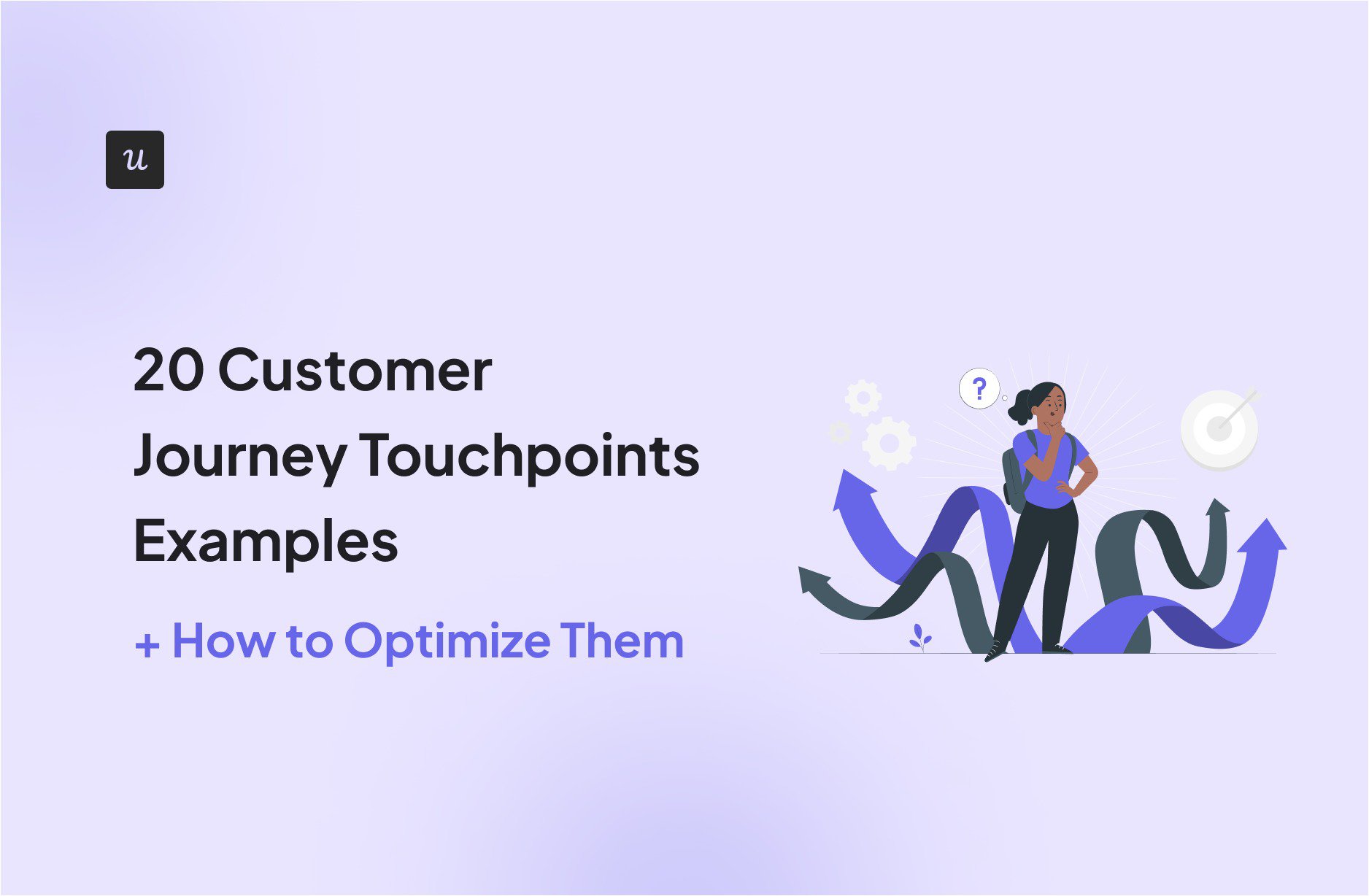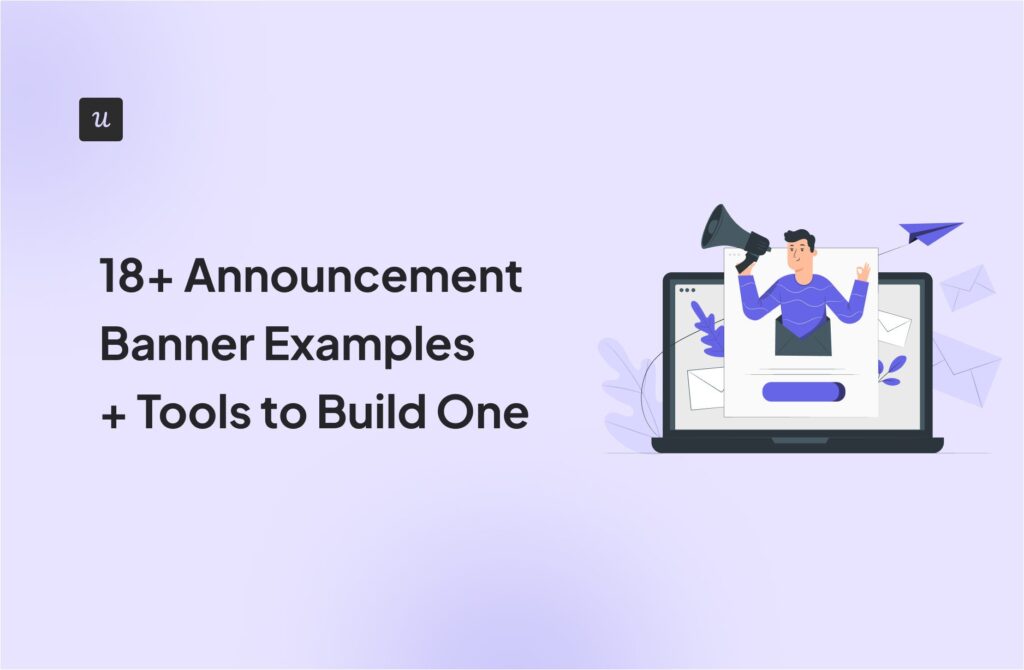
20 Customer Journey Touchpoints Examples + How to Optimize Them
Looking for examples of customer journey touchpoints?
If yes, you’re in the right place.
The article explores 20 major touchpoints in a SaaS product journey. And shows you how to optimize them for better conversions and higher customer satisfaction.
Let’s dive in.
Try Userpilot Now
See Why 1,000+ Teams Choose Userpilot

What are customer touchpoints?
Customer touchpoints are all the points of contact between the customer and the brand or the product along the customer journey.
By ensuring a positive customer experience across all touchpoints, SaaS companies can increase customer satisfaction, boost conversions, and strengthen relationships with their customer.
How do you identify customer touchpoints?
First, research your customers to find out what their needs and expectations are.
Next, analyze customer interactions using analytics tools and collect feedback about their background.
Finally, create a customer journey map with all touchpoints and associated actions, challenges, opportunities, and user feelings.
Important customer touchpoints before the purchase
The touchpoints at this stage get your product on the potential customer’s radar. They showcase its value and encourage them to explore what it has to offer in more depth.
1. Advertising
Advertising isn’t the most organic way to promote your product, but it’s very effective.
That’s because you can get it in front of your audience immediately and target very specific customer segments. This is particularly the case with PPC ads, like those on Google or social media. And retargeting enables you to keep them engaged with your brand.
Targeting and retargeting have one more benefit: they allow you to personalize the messages. That’s how you can highlight specific use cases and product benefits to relevant audiences.
To optimize your ads, track the performance of your campaigns with tools like Google Analytics and run A/B tests to identify those that best convert into landing page visits.

2. Content marketing
Content marketing involves creating and distributing valuable content. Like blog posts, whitepapers, eBooks, or video tutorials.
Product-led content, which presents your product as a solution to customer problems, can be particularly effective at attracting new customers and converting them into free-trial or demo bookings.
To get a good ROI on your content, ensure it addresses genuine user pain points and offers actionable insights.
To help your users find it, optimize it for search engines and distribute it across other channels, like social media. And track its performance to identify content that best resonates with your target audiences.

3. Social media platforms
Social media platforms are the most popular marketing channel at the moment. Platforms like LinkedIn, X, Facebook, YouTube, or TikTok are spaces where you can engage with potential customers, share your content, and build brand awareness.
To get the most out of this touchpoint, choose the platforms where your target audience hangs out. Post regularly to keep your audience engaged and respond to their comments and messages to build a community around your brand.
Visual content resonates best with social media users, so invest in videos, high-quality images, infographics, and carousels.

4. Email marketing
Email marketing involves sending targeted emails to potential customers to nurture leads and drive conversions. These could be newsletters, promotional offers, or drip campaigns.
Just like with other types of touchpoints, personalization is the key to email marketing success. Segment your email lists to send relevant messages to different audience groups, for example, based on their interests.
To increase open rates, craft engaging subject lines. Questions and subject lines with numbers tend to perform particularly well.
Finally, include strong CTAs in your emails to drive desired actions.

5. Webinars and events
Webinars and life events are an excellent way to attract new customers. They also keep your existing customers engaged and help them maximize the product value.
The idea is to run events that address common customer problems. For example, our July webinar focuses on converting free trials into paid accounts, which is one of the cornerstones of product-led growth.
Here’s the kicker:
In the webinars, we show the audience how to tackle their challenges with Userpilot capabilities.

6. Customer reviews
Customer reviews on pages like G2 or Capterra can encourage potential customers to explore your product further, so they should be part of your customer touchpoint strategy.
How do you optimize this touchpoint?
- Make sure your product pages on the review sites are up-to-date.
- Actively encourage existing customers to leave reviews. You can do it by targeting them with in-app messages.
- Always respond to feedback, especially if it’s negative. This shows your commitment to customer satisfaction and builds trust.

7. Word-of-mouth marketing
Word-of-mouth marketing is the most effective marketing types, both in terms of conversions and cost. Customers are more likely to trust people they know than your marketing campaigns.
While most of your happy customers promote your product organically, you can motivate them to go that little bit further. Set up a referral program and reward them for every new customer they refer.
Just like Revolut, a UK-based bank, which offers £40 to every newly-referred customer who set up an account.

Important customer touchpoints during the purchase decision
Having captured the attention of the potential customers, it’s time to close the deals now. Here are the key touchpoints that can help.
8. Free trials
Free trials give users the chance to try out the product before they commit to the purchase. The principle is simple: instead of telling users what the product can offer, let them experience it firsthand.
How can you optimize the touchpoint?
- Use analytics to determine the ideal trial length. It needs to be long enough to activate users.
- Cap usage to let users experience value without satisfying all their needs.
- Create personalized onboarding experiences to reduce time to value.

9. Demos
Demos can quickly showcase product features and benefits to the customers.
Live demos are particularly useful for complex products whose value may be difficult to experience during the trial. By showing users how relevant features work, they allow them to use the free trial more productively.
For best results, tailor your demos to specific use needs and use cases and make them interactive so that participants can ask any questions that they might have. You can also email the recording to the participants so that they can review it at their own pace.

10. Pricing pages
Pricing pages provide detailed information about the various pricing plans, features included, and payment options available for the SaaS product.
To help customers make informed decisions, present the pricing details clearly and transparently: show the final price without any hidden fees. Add-ons make things unnecessarily complicated.
On your pricing page, include comparison tables to highlight the differences between plans.
To increase conversions, provide information about free trials, discounts, and special offers.

11. Comparison tools
Comparison tools help potential customers compare how your SaaS product stacks against competitors. These could be in the form of interactive web tools, downloadable comparison charts, side-by-side feature comparisons, or X vs. Y blog posts.
To do their job, the comparison data needs to be up-to-date. And keep the resources objective. Biased comparisons are easy to see through and erode trust in your brand.

12. Product reviews and testimonials
Customers trust reviews and testimonials more than your marketing materials. In fact, 88% of customers tend to trust reviews from strangers as much as from people they know.
They hinge on powerful psychological principles to build your credibility and authority. Customers who see that other well-known companies have chosen your product are more likely to ‘conform’ to become a part of the exclusive club.
So?
Add testimonials and reviews to your money pages. Use images of real people, or even better, videos, as they convert the best.

Important customer touchpoints after the purchase
The customer swiping their credit card is just the beginning. The post-purchase touchpoints ensure they get adequate support and can get the value they’re paying for.
13. Thank you emails
Thank you emails are sent to users immediately after the purchase. To show your appreciation and confirm their transaction.
How do you write good thank you emails?
- Provide information on what the customer can expect next.
- Add a CTA that takes them to the login page or triggers an onboarding flow.
- Include links to additional resources, like tutorials.
- List well-known customers and include more testimonials to reassure the buyer they’ve made the right choice. In case they’re experiencing buyer’s remorse.
14. Upselling and cross-selling
Upselling and cross-selling involve promoting higher-tier plans or complementary products to existing customers to increase their lifetime value. And offer more value to customers.
You can achieve this through in-app messages that highlight the extra benefits of the add-ons or higher plans and prompt users to buy them.
Upsell/cross-sell messages are most effective when they:
- Target users who are ready for the upgrade, for example, power users.
- Are triggered contextually when the user experiences the need for a premium feature or hits a usage limit.

15. Customer service touchpoints
Customer service touchpoints are interactions where customers seek help with their issues or questions. For example, via live chat, phone, or email.
Having frictionless access to support is essential for customer satisfaction. A lack of it can lead to churn as users’ patience runs out.
Here are some optimization tips:
- Provide support via multiple channels.
- Aim for quick response times.
- Train the customer service team to ensure product knowledge and excellent communication skills.
16. Welcome emails
Welcome emails are the first emails sent to new customers.
Just like thank you emails, they introduce customers to the product and provide essential information.
They follow the same rules: they are personalized, provide clear instructions on the next steps, and include links to onboarding resources, FAQs, and support contacts.

17. In-app onboarding
In-app onboarding involves guiding new users through the product’s features and setup process directly within the application. Using tools like tooltips, interactive walkthroughs, and checklists.
- Use progressive disclosure to introduce information gradually. Not to overwhelm users.
- Personalize it based on their use cases. To make it relevant.
- Use interactive elements and gamification to increase engagement and information retention.

18. Customer loyalty programs
Customer loyalty programs reward repeat customers with benefits like discounts, exclusive access, or reward points. The purpose? To strengthen relationships with customers and drive retention.
For example, you could create a points-based system where customers earn points for completing tasks or reaching milestones, and can exchange them for perks.
You can optimize this touchpoint by offering valuable and relevant rewards, clearly explaining how the program works, and keeping them informed about the rewards they’ve earned and new opportunities.
19. Self-service resources
Self-service resources, like knowledge bases, resource centers, or chatbots, allow customers to find answers and solve issues on their own without contacting support. 24/7.
How to optimize them?
- Ensure the resources cover the most common issues comprehensively.
- Keep content up-to-date with the latest information and product updates.
- Collect customer feedback to improve the resources.

20. New feature releases
SaaS teams can communicate new feature releases and updates via multiple touchpoints: email, in-app messages, blog articles, social media posts, and release notes, to name just a few.
To ensure the users engage with the new features:
- Clearly explain how they work and what benefits they offer.
- Showcase use cases.
- Create how-to guides, tutorials, and onboarding flows to drive adoption.

Conclusion
Well-optimized customer journey touchpoints provide potential and existing customers with the information they need and drive desired behaviors. This translates into higher customer satisfaction, loyalty, and retention. And better business performance.
If you’d like to learn how to use Userpilot to identify and optimize customer journey touchpoints in your SaaS, book the demo!





![10 Free Product Roadmap Templates You Need in 2026 [+Free Download] cover](https://blog-static.userpilot.com/blog/wp-content/uploads/2026/01/10-product-roadmap-templates-you-need-in-2026-free-download_d8269f0b0b9749f6ad7b519ab7ac1833_2000-1024x670.png)
